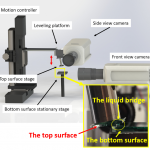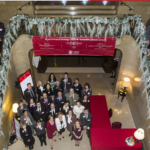Study of Droplet Evaporation
Study of droplet evaporation is important in many industrial applications from heat transfer in microelectronics, and batteries, to cleaning industry. We have studied natural evaporation of droplets and when they are subjected to an electric field (see figure below).


In a series of papers, we have shown how contact angle effects the evaporation rate from a theoretical perspective. Experimentally we have also shown the effect of electric field on changing the evaporation rate of droplets that can be useful for advanced cooling systems. More details can be found in the following references as a sample of our works.
Almohammadi, A. Amirfazli, “Sessile drop evaporation under an electric field”, Colloids & Surfaces A, 555, 580-585, 2018.
S.F. Chini, A. Amirfazli, “Resolving an Ostensible Inconsistency in Calculating the Evaporation Rate of Sessile Drops”, Adv. Colloid Interface Sci. 243, 121-128, 2017.
F. Chini, A. Amirfazli, “Understanding the evaporation of spherical drops in quiescent environment”, Colloid Surfaces A, 432, 82-88, 2013.
Liquid bridges are seen in many systems such as printing, wet adhesion systems, vari-focal lenses, gluing, and water harvesting systems. It is also seen in nature, e.g., responsible for explaining how some insects walk on vertical walls.
A liquid bridge is seen, when a volume of liquid is trapped between two surfaces. We have looked at liquid bridge systems with Newtonian and Non-Newtonian liquids.

In a series of papers, we have established the rules for liquid bridge breakup based on contact angle and contact line pining. We can predict how the volume of a liquid bridge will be divided between two surfaces, if the bridge is extended.






